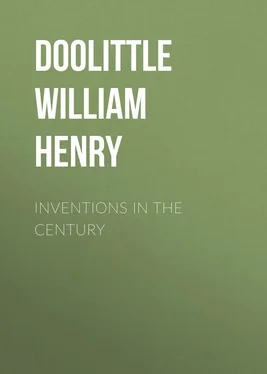Before opening the door of the 19th century, let us glance at one more experiment in the 18th:
While the aged Franklin was dying, Dr Luigi Galvani of Bologna, an Italian physician, medical lecturer, and learned author, was preparing for publication his celebrated work, De viribus Electricitatis in Motu Musculari Commentarius , in which he described his discovery made a few years before of the action of the electric current on the legs and spinal column of a frog hung on a copper nail. This discovery at once excited the attention of scientists, but in the absence of any immediate practical results the multitude dubbed him the "frog philosopher." He proceeded with his experiments on animals and animal matter, and developed the doctrine and theories of what is known as animal or galvanic electricity. His fellow countryman and contemporary, Prof. Volta of Pavia, took decided issue with Galvani and maintained that the pretended animal electricity was nothing but electricity developed by the contact of two different metals. Subsequent investigations and discoveries have established the fact that both theories have truth for their basis, and that electricity is developed both by muscular and nervous energy as well as by chemical action. In 1799 Volta invented his celebrated pile, consisting of alternate disks of copper and zinc separated by a cloth moistened with a dilute acid; and soon after an arrangement of cups – each containing a dilute acid and a copper and a zinc plate placed a little distance apart, and thus dispensing with the cloth. In both instances he connected the end plate of one kind with the opposite end plate of the other kind by a wire, and in both arrangements produced a current of electricity. To the discoveries, experiments, and disputes of Galvani and Volta and to those of their respective adherents, the way was opened to the splendid electrical inventions of the century, and the discovery of a new world of light, heat, speech and power. The discoveries of Galvani and Volta at once set leading scientists at work. Fabroni of Florence, and Sir Humphry Davy and Wollaston of England, commenced interesting experiments, showing that rapid oxidation and chemical decomposition of the metals took place in the voltaic pile.
Конец ознакомительного фрагмента.
Текст предоставлен ООО «ЛитРес».
Прочитайте эту книгу целиком, купив полную легальную версию на ЛитРес.
Безопасно оплатить книгу можно банковской картой Visa, MasterCard, Maestro, со счета мобильного телефона, с платежного терминала, в салоне МТС или Связной, через PayPal, WebMoney, Яндекс.Деньги, QIWI Кошелек, бонусными картами или другим удобным Вам способом.












